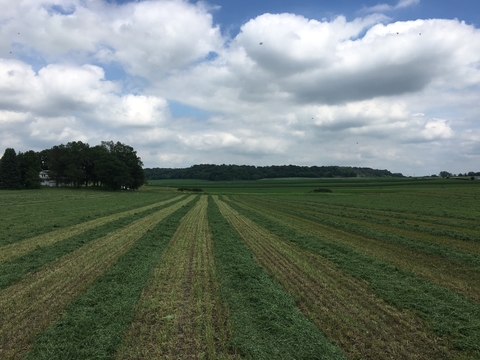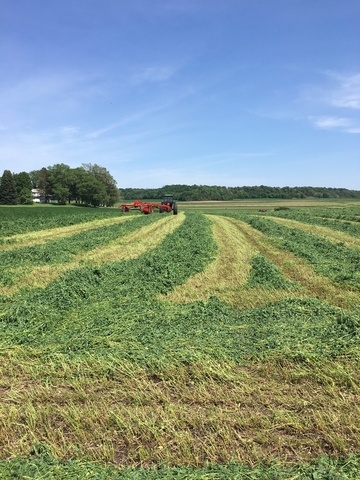Quick facts
-
Tedding can be a useful tool to increase drying rate and preserve the concentration of important nutrients in alfalfa silage. Tedding is the process of lifting and spreading out mowed hay.
-
Tedding adds cost to production. To determine financial feasibility, use the Plug in Decision Tool for Tedding Costs.
-
Alfalfa is an important forage to livestock owners and can be fed as pasture, hay or silage. Silage is popular because it is more resistant to spoilage and requires less drying time compared to alfalfa harvested for hay.
How does tedding affect drying rate and quality?
The practice of tedding can increase drying rate but comes with a cost of added time, expenses and equipment. Additionally, tedding may impact quality as this is an added handling step in harvesting.
Research found tedding increased drying rate, resulting in a lower harvest moisture at all cuttings. Nutritional quality was also affected with the exception of total digestible nutrients (TDN); see table 1. At all cuttings, crude protein (CP) decreased by tedding and water-soluble carbohydrates (WSC) increased.
Table 1. Composition of tedded and un-tedded treatments averaged across each cutting of the field study
| Cutting | Treatment | Harvest moisture content, % wet basis1 | CP, %, dry matter1 | Neutral detergent fiber (NDF), % dry matter1 | WSC, % dry matter1 | Ash, % dry matter1 | TDN, % dry matter1 |
|---|---|---|---|---|---|---|---|
| 1 | Un-tedded | 69a | 21.9a | 41.1 | 5.4a | 10.5 | 65.9 |
| 1 | Tedded | 58b | 21.4b | 41.3 | 6.2b | 10.6 | 66.1 |
| 2 | Un-tedded | 65a | 20.9a | 42.4 | 5.2a | 11.7a | 64.5 |
| 2 | Tedded | 49b | 20.4b | 42.0 | 6.3b | 10.7b | 64.7 |
| 3 | Un-tedded | 521 | 22.3a | 32.7a | 8.9a | 10.8a | 67.3 |
| 3 | Tedded | 47b | 21.5b | 35.1b | 9.5b | 9.4b | 67.0 |
1Columns within each cutting with different superscripts are statistically different (P≤0.05).
Water soluble carbohydrates are, as the name implies, water soluble. Therefore, the longer a forage takes to dry (or is allowed to dry), the more WSCs are lost.
Tedding appears to help preserve WSC by speeding the rate of drying.
Neutral detergent fiber was different at the third cutting only and was increased by tedding.
Due to NDF being a structural fiber that accumulates in the plant with growth, it is unlikely that fermentation would generate more indigestible fiber. Therefore, changes in NDF most likely reflect leaching of other nutritional components, for example WSC, resulting in a concentration of NDF.
Ash was reduced in the tedding treatment for the second and third cuts. Ash content may have been impacted by the weight of the swaths as the un-tedded regions were heavier and had more contact with the soil when drying, potentially picking up more ash material from the soil.
Water-soluble carbohydrates and fermentation
Silage is created by harvesting, processing, and storing forage, or grain crops, in a way that allows for fermentation. When creating silage, it is important to harvest so that both yield and quality are maximized, but this can be challenging as they are influenced by multiple factors. Effects of plant drying and weather damage are closely related. On the other hand, if allowed to dry too much, fermentation is not achieved, and leaf shatter — or loss — may occur and result in the loss of valuable plant material.
In order for fermentation to occur successfully, an ideal WSC concentration and moisture level must be met. In the event that WSC concentration is below optimal levels, additives can increase total WSC concentration.
Legumes, such as alfalfa, can be tricky in regard to WSC as they have a high buffering capacity, meaning that they are resistant to pH changes that are necessary for fermentation; therefore, they require higher WSC levels compared to grasses for successful fermentation.
See figure 1 for ideal WSC concentrations. In this study, WSC were below optimal levels for alfalfa silage production for both treatments in the first cut, but in the second cutting, tedding increased WSC to the optimal range, and in the third cutting, both harvest methods produced optimal WSC concentrations.
Figure 1. Water-soluble carbohydrate concentration required for fermentation of alfalfa in silage production (adapted from Pitt, 1990 and Romero et al., 2015).
The practice of tedding can be used to increase drying rate, but comes with a cost of added time, additional expenses and equipment. Additionally, tedding may impact quality as this is an added handling step in the harvesting processes. However, tedding can be a positive impact by increasing WSC or a negative one by reducing CP, likely caused from leaf loss.
-
In order to evaluate the practicality of tedding in alfalfa silage production, the University of Wisconsin-River Falls conducted a study to determine if tedding is useful in the production of alfalfa silage.
-
The study included three harvest dates in the spring and summer of 2018 (May 28, June 27, and July 23).
-
Alfalfa was harvested at the early bud maturity stage and subdivided into treatment (tedded) and control (un-tedded) sections. At the time of harvest, moisture ranged from 47 to 69%.
-
Prior to harvest, samples were collected to estimate nutritional quality and yield. Nutritional quality was determined by near-infrared spectroscopy to estimate neutral detergent fiber, water-soluble carbohydrates, ash, and total digestible nutrients, and yield was measured on a dry matter basis.
-
At each harvest, the entire field was cut using a mower conditioner with a 13-foot cut width, then divided into tedded and un-tedded sections. Windrow swath width was approximately 5 feet.
-
Immediately after cutting, tedded regions were tedded at a ground speed of 3.5 miles per hour and PTO speed of 540 rotations per minute.
-
The following day, a pull-type forage harvester was used to merge sections of the field. Each tedded and un-tedded section of the field was collected in an individual wagon. From each wagon, 10 to 15 subsamples were collected for evaluation of nutritional quality at harvest.
-
Figure 1 adapted from Pitt, 1990 and Romero et al., 2015.
Reviewed in 2023






